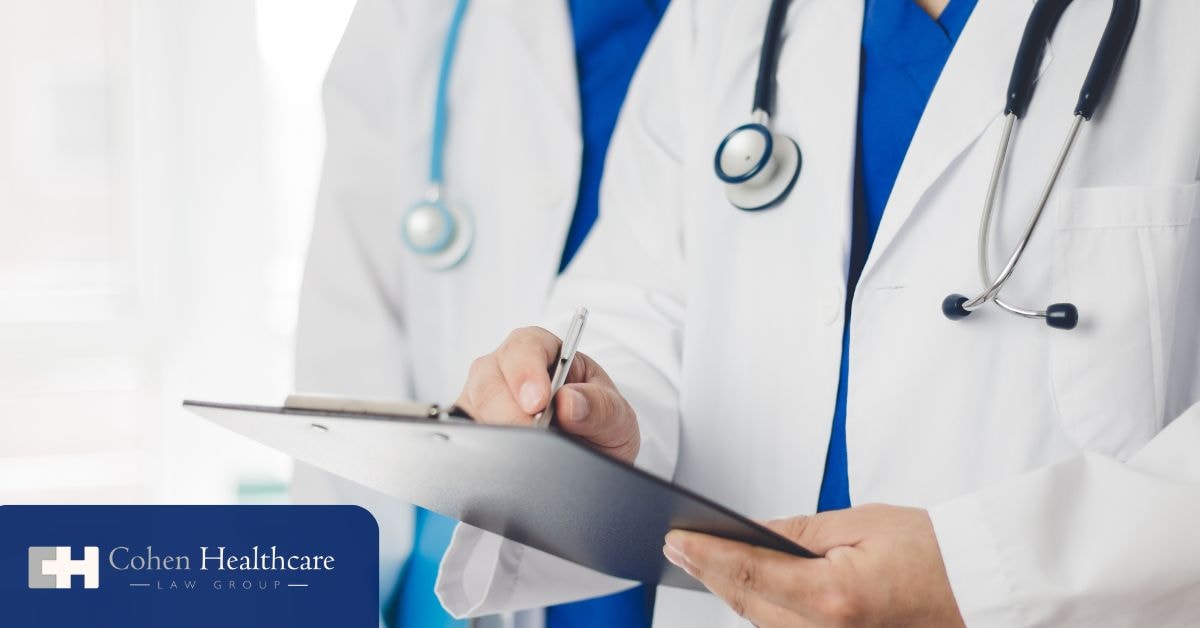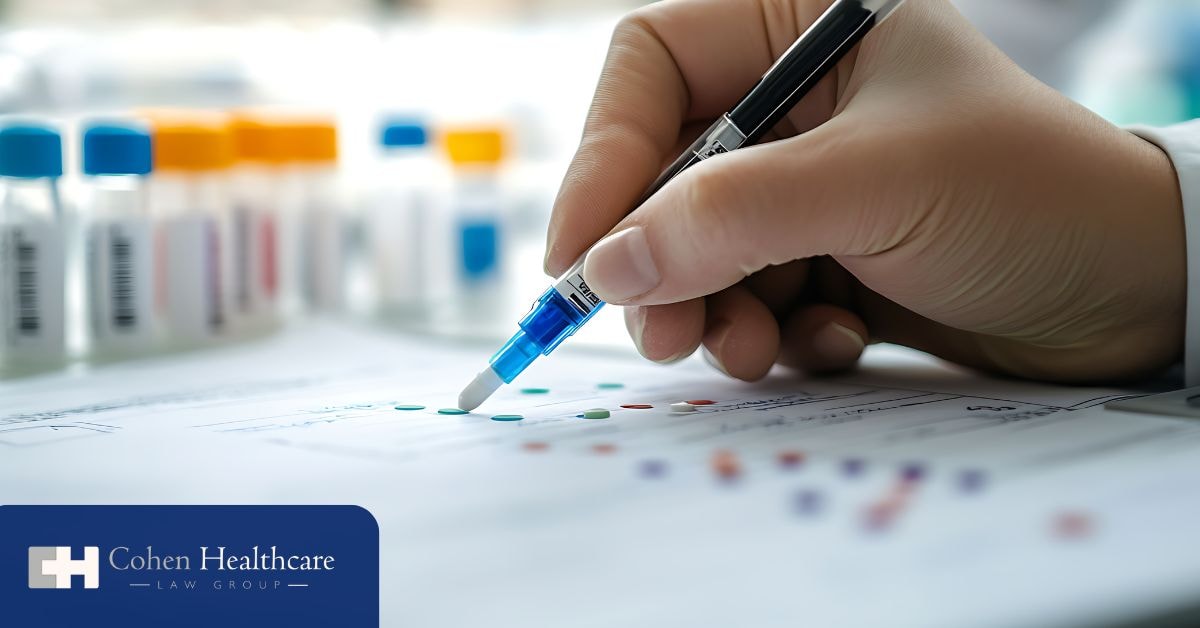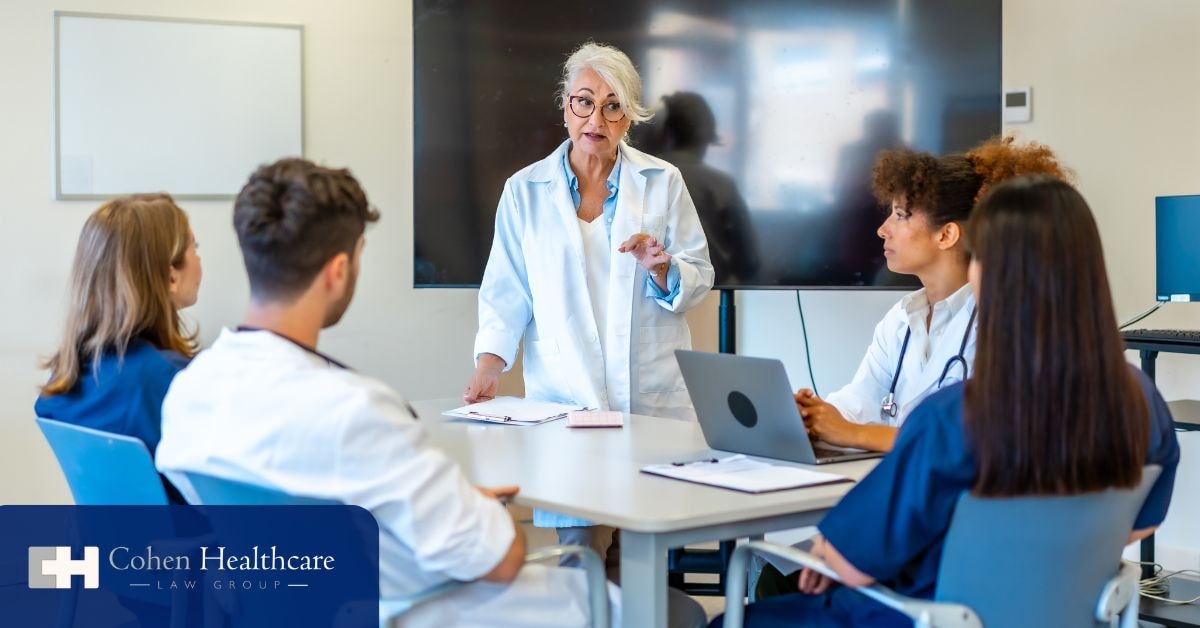
Laboratory compliance is foundational to safe, legal, and credible medical testing operations. Whether you run a diagnostic lab, clinical research facility, or pathology service, failure to meet regulatory standards can result in fines, loss of licensure, or reputational ruin. But achieving medical laboratory compliance efficiently is possible when you align policies, systems, and legal strategy.
At Cohen Healthcare Law Group, we have over 25 years of experience in offering compliance and regulatory counsel tailored to labs, clinics, and other healthcare facilities. Contact us today for a consultation!
In this post, we’ll break down what laboratory compliance really means, the key laws and standards you must obey, and practical steps to streamline your journey.
What Is Laboratory Compliance?
Laboratory compliance refers to the process of ensuring that a clinical laboratory or testing facility follows all applicable regulations, industry guidelines, and compliance requirements governing safe and reliable laboratory operations. It’s the foundation of trust, accuracy, and safety in healthcare and research. Through strong lab compliance, organizations demonstrate their ability to comply with regulations set by regulatory agencies such as the FDA and other US government bodies that oversee testing, reporting, and data integrity.
A robust compliance program also integrates technology such as a laboratory information management system (LIMS) to streamline lab processes, monitor activities, and ensure records are properly maintained. The use of LIMS helps laboratories achieve compliance more efficiently by automating workflows, tracking samples, managing equipment maintenance and calibration, and generating the necessary evidence for laboratory inspection. This ensures that every result can be traced back to its source, maintaining data integrity and accountability.
It’s important to distinguish between compliance, quality control, and accreditation, even though they work hand in hand. Compliance focuses on meeting regulatory compliance and legal standards. Quality control ensures test results are accurate, consistent, and reliable through systematic checks and testing practices. Accreditation, on the other hand, involves independent validation by recognized organizations that confirm the lab’s adherence to industry standards and guidelines. Together, these elements allow lab managers, lab employees, and administrators to build effective, compliant laboratory operations that can withstand both internal review and external oversight.
Why Laboratory Compliance Is Crucial for Medical and Clinical Labs
Adhering to laboratory compliance is essential for maintaining trust, safety, and operational excellence. Every clinical laboratory has to follow the rules set by regulatory agencies to protect patients, employees, and data. By developing a structured compliance program, laboratories can identify risks, establish controls, and take preventive action before compliance issues arise. The procedure includes everything from equipment calibration and staff training to documentation and audit trails that provide evidence of compliance.
Effective lab compliance protects both staff and patients by reducing the risk of accidents involving toxic chemicals, preventing physical damage, and ensuring proper handling of biological materials. Following strict standard operating procedures and maintaining a culture of safety ensures that laboratories remain compliant while promoting accountability among lab employees. It also allows lab managers to clearly define responsibilities, implement processes, and monitor operations to prevent errors that could lead to injury or regulatory penalties.
Beyond safety, laboratory compliance is vital for preserving data integrity and research credibility. In fields like pharmaceutical production and diagnostic testing, even the smallest breach of data accuracy can have major consequences. Quality control processes, internal audits, and external audits ensure that lab data remains trustworthy, verifiable, and ready for inspection. The use of laboratory information management systems supports these procedures by maintaining organized records, creating digital audit trails, and minimizing human error. Such transparency not only meets regulatory compliance standards but also strengthens confidence in a lab’s results and reputation.
When non-compliance occurs, the consequences can be devastating. A laboratory that fails to comply with established regulations risks severe regulatory issues, financial penalties, license suspension, and even shutdown. In worst-case scenarios, inaccurate data may lead to patient harm, contamination, or widespread physical damage. The long-term effects of non-compliance can destroy years of credibility, making recovery difficult. Maintaining a proactive compliance program, with regular audits, training, and continuous monitoring, ensures that a lab operates ethically and meets every compliance requirement efficiently and reliably.
Key Regulatory Bodies and Standards
In the United States, several regulatory agencies oversee different aspects of lab operations, ensuring that testing, reporting, and safety standards are met consistently. The Food and Drug Administration (FDA) regulates laboratories involved in pharmaceutical production, diagnostics, and medical testing to ensure that all lab data is accurate, reliable, and backed by sound quality control. The Clinical Laboratory Improvement Amendments (CLIA) set federal compliance requirements for testing performed on human samples, focusing on quality assurance, personnel qualifications, and equipment calibration.
Meanwhile, the Occupational Safety and Health Administration (OSHA) establishes standards to protect lab employees from exposure to toxic chemicals, biological hazards, and other workplace risks, while the Environmental Protection Agency (EPA) enforces environmental regulations that govern waste disposal, emissions, and contamination control during laboratory operations. Beyond the U.S., international bodies such as the International Organization for Standardization (ISO) provide global frameworks, with ISO 17025 serving as the gold standard for laboratories seeking accreditation in testing and calibration.
The difference between national and international compliance standards lies mainly in scope and recognition. National regulations like CLIA or FDA requirements are mandatory within the United States and enforced by government authorities. They define the minimum compliance requirements a laboratory must meet to remain legally operational. International standards, such as ISO 17025 or ISO 15189, are globally recognized and voluntary but often essential for laboratories that collaborate across borders or wish to demonstrate excellence beyond local laws. Many lab managers choose to align their compliance programs with both national and international standards to ensure competitiveness, data integrity, and credibility in the global industry.
Meeting these combined standards involves maintaining thorough documentation, performing regular internal audits and external audits, implementing standard operating procedures (SOPs), and continuously training lab employees to ensure full regulatory compliance. By aligning with these key agencies and standards, laboratories can achieve compliance, prevent regulatory issues, and sustain the highest level of testing accuracy and reliability.
Good Laboratory Practice Compliance
Good Laboratory Practice (GLP) compliance is another critical part of maintaining reliable and ethical lab operations. GLP refers to a set of principles and guidelines that govern the planning, performance, monitoring, recording, and reporting of non-clinical laboratory studies. Established originally by the FDA and later adopted internationally through the Organisation for Economic Co-operation and Development, GLP ensures that laboratories conducting safety and efficacy testing produce accurate data that regulatory authorities can trust.
Unlike general laboratory compliance, which focuses on meeting all regulatory compliance obligations, GLP compliance zeroes in on the scientific integrity and traceability of research. To ensure the verification of every experiment, result, and conclusion, it necessitates detailed documentation requirements, well-defined standard operating procedures, and robust audit trails. Following GLP standards also means maintaining strict equipment maintenance and equipment calibration schedules, ensuring staff training, and implementing effective quality control processes to eliminate errors.
The benefits of following Good Laboratory Practice are far-reaching. Laboratories that adopt GLP principles enhance the credibility and reproducibility of their research, reduce the likelihood of compliance issues, and minimize the risk of non-compliance findings during laboratory inspection. By adhering to GLP, lab managers and lab employees can demonstrate that their data integrity, quality assurance, and processes meet internationally accepted expectations. This not only helps regulatory bodies like the FDA and EPA, but it also strengthens relationships with clients, pharmaceutical companies, and international partners who depend on accurate data and ethical testing methods.
When comparing GLP to general laboratory compliance, the distinction is in focus and purpose. General lab compliance ensures that a laboratory meets legal regulations, safety requirements, and operational standards for day-to-day lab processes and audits. GLP compliance, however, specifically governs how research data is produced, validated, and stored, providing scientific credibility that complements a broader compliance program. Together, they create a comprehensive framework that ensures both regulatory compliance and scientific integrity, enabling laboratories to operate safely, ethically, and efficiently in a competitive, high-stakes environment.
Common Laboratory Compliance Requirements
Whether managing a clinical laboratory, research facility, or pharmaceutical production site, lab managers must implement standard operating procedures (SOPs), maintain accurate documentation, and conduct regular internal audits to achieve compliance. Important laboratory compliance requirements include:
Safety and Environmental Regulations
Compliance efforts start with ensuring laboratory safety. Laboratories must properly handle toxic chemicals, hazardous materials, and waste to prevent contamination and harm to lab employees. Standard operating procedures should define waste disposal protocols, spill response measures, and emergency evacuation plans.
Staff training is also critical, as every employee must understand how to conduct procedures safely and comply with environmental protection regulations set by the US government, OSHA, and the EPA. Regular laboratory inspections and audits verify that safety measures, documentation requirements, and maintenance practices meet established compliance standards. Proper implementation protects staff and the environment and enhances the reliability of laboratory operations.
Equipment and Instrumentation Compliance
To achieve compliance, laboratories must ensure that all instruments are properly calibrated, validated, and maintained. Equipment maintenance and calibration logs are key compliance requirements that regulatory agencies like the FDA and ISO rely on for verification.
Each instrument used in testing must undergo validation before use, and records must be accurately maintained to demonstrate traceability. A structured compliance program helps lab managers monitor instrument performance, prevent errors, and support data accuracy. Proper documentation and audit trails offer clear evidence of adherence to regulations, ensuring the accuracy and reliability of laboratory data and minimizing compliance issues during external audits.
Personnel and Training Compliance
Lab compliance heavily depends on qualified, well-trained personnel. Every staff member must meet certification and qualification requirements relevant to their responsibilities. Regular staff training ensures that lab employees remain updated on regulations, quality assurance protocols, and best practices.
Documenting training sessions and certifications is part of the compliance program and serves as proof of adherence during audits or inspections. Lab managers must also establish clear SOPs for personnel conduct, assign responsibilities, and monitor performance to maintain compliance consistency. Continuous training strengthens laboratory operations and reduces risk by reinforcing safety practices, data reliability, and procedural accuracy across departments.
Data Management and Documentation
Maintaining accurate laboratory data and proper documentation is at the heart of laboratory compliance. Laboratories must keep complete and accurate records of tests, samples, and processes, whether in electronic or paper form. A compliant laboratory information management system (LIMS) ensures data integrity by managing audit trails, access permissions, and documentation requirements.
Regulatory agencies often review record retention policies, documentation accuracy, and evidence of data monitoring to ensure laboratories meet compliance requirements. Proper data management supports quality control and internal and external audits and provides reliable evidence during regulatory inspections. Ultimately, effective documentation practices protect laboratories from non-compliance risks and preserve the credibility of lab results in the scientific and medical community.
How to Ensure Lab Compliance
Start by conducting regular compliance audits or self-assessments to identify gaps, risks, and areas of non-compliance. Internal audits help verify that laboratory operations, such as equipment maintenance, calibration, data recording, and sample testing, adhere to established standards. These evaluations also furnish proof of compliance for external audits and regulatory inspections, guaranteeing your lab’s constant readiness.
Developing comprehensive standard operating procedures (SOPs) is equally important. SOPs outline consistent steps for everything from sample handling to waste management, enabling lab managers and employees to conduct processes accurately and safely. You should regularly review and update SOPs to keep your lab processes in line with current compliance requirements and best practices.
Training your team is another critical part of achieving compliance. Every lab employee must receive onboarding and ongoing staff training to understand safety measures, documentation requirements, and data integrity standards. Continuous education helps prevent errors, supports quality control processes, and reinforces a culture of accountability across all laboratory operations.
To streamline these compliance efforts, laboratories should implement a compliance management system or laboratory information management system (LIMS). These digital tools simplify tracking of SOPs, audit results, training records, and documentation updates. They also generate automatic audit trails, monitor corrective actions, and maintain accurate laboratory data, helping labs stay organized, efficient, and inspection-ready.
Finally, navigating regulatory compliance can be overwhelming without expert legal guidance. Partnering with an experienced healthcare attorney can help you interpret regulations set by multiple agencies, establish preventive action plans, and respond effectively to compliance issues. Our experienced legal team at Cohen Healthcare Law Group provides trusted counsel for laboratories seeking to maintain compliance, avoid costly penalties, and strengthen their overall operations. Contact Cohen Healthcare Law Group today to ensure your lab meets every compliance requirement confidently and efficiently.
Ready to Ensure Your Lab Meets All Compliance Standards?
Staying on top of laboratory compliance is about protecting your staff, patients, and reputation. By conducting regular internal audits, maintaining clear standard operating procedures (SOPs), investing in continuous staff training, and using a reliable laboratory information management system (LIMS), your lab can operate efficiently while meeting every regulatory compliance requirement. Proactive compliance helps prevent costly fines, equipment downtime, and legal complications, all while strengthening data integrity and workplace safety.
Don’t wait until non-compliance becomes a problem. Our experienced attorneys at Cohen Healthcare Law Group specialize in helping laboratories establish, monitor, and maintain compliance programs that align with FDA, OSHA, CLIA, and other agency standards. Reach out to us today!
FAQ
Below are answers to some frequently asked questions to help lab managers, compliance officers, and laboratory employees stay informed and compliant with federal and industry guidelines:
What Does CLIA Compliance Mean?
CLIA compliance refers to meeting the requirements set by the Clinical Laboratory Improvement Amendments (CLIA), which regulate all clinical laboratory testing performed on humans in the U.S. It ensures that laboratories produce accurate, reliable, and timely test results, maintaining high standards of quality control, data integrity, and regulatory compliance.
How Much Does a CLIA Certification Cost?
The cost of a CLIA certificate depends on the type of testing your clinical laboratory performs. Fees typically range from a few hundred to several thousand dollars, based on the complexity of the tests. Laboratories must also pay renewal fees every two years to maintain active certification and continue to achieve compliance with federal standards.
What Are the Three Types of CLIA Certificates?
CLIA regulations recognize three main certificates:
- Certificate of Waiver—for simple tests with a low risk of error.
- Certificate for Provider-Performed Microscopy (PPM)—for moderately complex microscopy tests.
- Certificate of Compliance or Accreditation—for complex testing requiring strict quality assurance, standard operating procedures, and regular inspections by regulatory agencies.
What Are The Requirements For Lab Safety?
Laboratory safety requirements include proper handling of hazardous and toxic chemicals, using personal protective equipment (PPE), maintaining equipment calibration, and following waste disposal protocols. Labs must also establish emergency procedures, conduct staff training, and ensure regular internal audits to prevent accidents and compliance issues.
What Does PEL Stand For?
PEL stands for Permissible Exposure Limit, a safety standard set by OSHA that defines the maximum amount of a substance or chemical a worker can be exposed to during a workday. Monitoring and controlling exposure levels are essential parts of laboratory risk management and regulatory compliance.
Who Is Responsible for Lab Safety?
Lab managers and supervisors hold primary responsibility for ensuring lab safety and compliance with all regulations set by the US government and relevant regulatory agencies. However, every lab employee plays a role by following SOPs, reporting risks, and adhering to compliance requirements to maintain a safe and efficient work environment.
Contact Us




